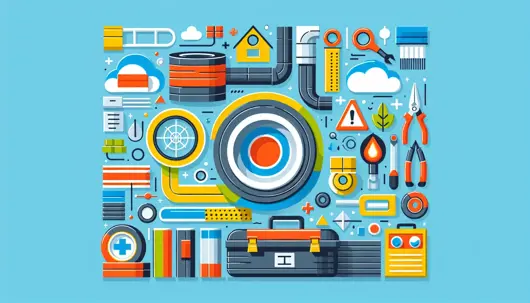Introduction to Duct Sealing and Its Importance
Duct sealing might not sound like the most exciting thing in the world, but hear me out, it’s a game changer for your home’s air quality. Picture your home’s air duct system as the lungs of your house. Just like lungs, if there’s a leak, the system can’t work right. Duct sealing simply means finding and fixing those leaks. Why bother? Well, leaks can let in dust, pollen, and other outdoor air pollutants. They also let cooled or heated air escape, making your HVAC system work harder. This means you’re paying more for energy to essentially heat or cool your backyard. Not smart, right? By sealing those leaks, you keep the bad stuff out, the good stuff in, and save money on energy bills. It’s a straightforward fix that brings comfort, improves air quality, and cuts costs. So, while duct sealing might not be the first thing on your mind, its importance shouldn’t be underestimated.
How Duct Sealing Affects Indoor Air Quality
Duct sealing might not sound like a big deal, but it’s a game-changer for your home’s air quality. Let’s cut to the chase: when your ducts have leaks, two things happen. First, dirty air from places like your attic or basement sneaks into your system and ends up in your living room. Not great, right? Second, the air you paid to heat or cool escapes. So, your HVAC system works overtime, but your house still doesn’t feel right. It’s like trying to fill a bucket with a hole in it. Sealing those ducts means you keep the good air in, and the bad air out. It’s pretty straightforward – sealed ducts lead to cleaner air and a more comfortable home. Plus, your HVAC system can chill because it doesn’t have to work as hard. This means less wear and tear on your system and, let’s not forget, potential savings on your energy bills. Simply put, duct sealing is a must-do for better air quality and a more comfy, cost-efficient home.
Common Problems Caused by Unsealed Ducts
Unsealed or poorly sealed ducts lead to a bunch of problems you’d rather not deal with. First off, they let conditioned air escape. Imagine paying to cool or heat your air, only for it to slip away before it even gets to you. That’s money down the drain, literally. This means your system has to work harder, chewing up more energy and hiking up your bills. Not cool. Then there’s the issue of contaminants. Unsealed ducts suck in dust, pollen, and all sorts of unwanted guests from your attic, crawlspace, or wherever they run through. These uninvited particles then waltz right into your living spaces, polluting your air. If you or someone in your home is an allergy sufferer or has respiratory issues, this is bad news. Plus, unsealed ducts can lead to uneven heating or cooling. Some rooms turn into saunas while others feel like ice boxes. It’s like living in several climates under one roof, and nobody wants that hassle. So, in short, unsealed ducts mess with your comfort, your health, and your wallet.
The Benefits of Duct Sealing for Homeowners
Sealing your ducts is like patching up leaks in a boat; it keeps the good stuff in and the bad stuff out. When you seal your ducts, you’re not just saving money on energy bills, you’re also boosting your home’s air quality. Let’s break it down. First off, energy savings. Sealed ducts mean your heating and cooling systems don’t have to work as hard. This cuts down on energy use and puts money back in your pocket. We’re talking about potentially shaving off up to 20-30% of your energy bill. Next, air quality. Holes in your ducts can pull dust, pollutants, and even pests into your home. Sealing them up means cleaner air, fewer allergens, and a healthier environment for you and your family. Plus, it helps your HVAC system last longer. No extra strain means fewer repairs and a longer life for your system. Simple, right? Seal those ducts, save money, breathe easier, and keep your home running smoothly.
Identifying Signs That Your Ducts Need Sealing
You might not think about your air ducts often, but these hidden pathways play a crucial role in keeping your home’s air clean and your energy bills in check. Knowing when they need a bit of attention can save you from bigger problems down the road. Here’s how you can tell it’s time to call in the pros for duct sealing. First, if your energy bills are suddenly climbing without a clear reason, leaky ducts might be the culprit. They force your HVAC system to work harder, driving up costs. Second, do you notice inconsistent temperatures in different rooms? If one room is always too hot or too cold compared to the rest of your house, your ducts may be leaking. Third, if there’s a musty scent or you’re sneezing more than usual, it might not just be the changing seasons. Dust and mold can accumulate in leaky ducts and get circulated around your home. Lastly, if you can actually see holes or gaps in the ductwork, that’s a clear sign. If any of these sound familiar, it’s probably time to seal those ducts and boost your home’s comfort and air quality.
Professional vs. DIY Duct Sealing: What You Need to Know
When it comes to duct sealing, you’ve got two main routes: hiring professionals or doing it yourself (DIY). Professionals know the ins and outs, have the right tools, and ensure your ducts are sealed correctly, improving your home’s air quality and energy efficiency. It might cost more upfront, but you’re paying for expertise and peace of mind. On the flip side, DIY duct sealing can be cheaper. You’ll need to buy materials like mastic sealant or metal tape, and invest time in learning how to properly seal leaks. While you save on labor costs, there’s a risk of missing leaks or not sealing them adequately, which could cost more in the long run due to increased energy bills or the need for professional repairs later. Bottom line: weigh the costs, your skill level, and the time you can commit before deciding.
The Duct Sealing Process: Step by Step
First up, your HVAC pro will inspect your ducts to spot leaks, rips, or disconnected parts. They’re like detectives, searching for clues of where air might be escaping. Once they’ve found the problem spots, the real work begins. They might start with a simple sealing tape for small leaks, kind of like putting a bandaid on a cut. For bigger issues, mastic sealant or metal-backed tape gets the job done. This stuff is tough and can handle more serious leaks. It’s like using super glue for your air ducts. In some cases, they might bring in a heavy hitter, like an aerosol sealant. They pump this through your ducts, and it seals up leaks from the inside out. Think of it as sending a mini robot through your ducts to fix leaks you can’t even see. The whole process can be a bit noisy and might take a few hours, but it’s worth it. Sealing those leaks means your air conditioner or heater doesn’t have to work overtime, saving you money on energy bills and making your home’s air cleaner and more comfortable.
How to Choose the Right Materials for Duct Sealing
Choosing the right materials for duct sealing is key to making sure your air conditioning and heating system works efficiently. You’ve got a couple of options. First, mastic sealant is a go-to. It’s kind of like a thick paint that you brush over the seams and joints of your ductwork. It’s sturdy, dependable, and handles temperature changes well. Just apply it directly on clean surfaces, and you’re good to go. Then, there’s foil-backed tape. It’s not your average tape; this stuff is made to stick and stay on metal ductwork, sealing those gaps tight. Steer clear of the “duct tape” you find at the hardware store for everyday fixes; it’s not cut out for this job. Both these options will seal your ducts effectively, keeping your air clean and making sure you’re not wasting energy. Remember, a well-sealed duct system means better indoor air quality and lower utility bills. Choose based on what works best for your situation and budget, but don’t skimp on quality. Your choice will keep your air system running smooth and efficient.
Maintaining Your Ducts After Sealing
After getting your ducts sealed, it’s crucial to maintain them to ensure they keep performing well. Here’s the deal. First off, regularly check for leaks. Even a well-sealed system can develop new leaks, especially at connections and joints. Use your hands to feel for air escaping or use a smoke pencil to see if there’s any unusual airflow. Next, keep your ducts clean. Dust and debris can build up over time, even in sealed ducts. Every couple of years, consider having a professional clean your ducts to keep the air flowing smoothly. Also, don’t forget about your filters. Change them every few months, depending on what your system requires. A clogged filter can strain your HVAC system and introduce particles into your ducts. Finally, keep an eye on your HVAC system’s performance. If it seems like it’s working harder or your energy bills are creeping up, it might be time to inspect your ducts again. Remember, maintaining your ducts isn’t just about saving money; it’s about keeping your indoor air clean and your living space comfortable.
Conclusion: The Long-Term Value of Duct Sealing
Sealing your ducts isn’t just a quick fix; it’s an investment in your home’s health and comfort. By choosing to seal your ducts, you’re siding with energy efficiency, lower utility bills, and a significant improvement in indoor air quality. Remember, unsealed or poorly sealed ducts leak air, strain your HVAC system, and pull in pollutants from unconditioned spaces. By fixing these leaks, you’re looking at savings of up to 20% on your heating and cooling costs. More than that, you’re taking a big step toward a healthier living environment by reducing the risk of pollutants and allergens circulating through your home. In the long run, duct sealing pays for itself through these savings and the undeniable boost in your quality of life. It’s clear: the value of duct sealing extends far beyond the initial outlay. It’s about making a smarter, healthier, and more cost-effective choice for your future.

